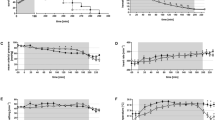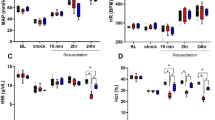Abstract
Objective
To investigate the efficacy of a polyethylene glycol (PEG) modified formulation of liposome-encapsulated hemoglobin (LEH) as an oxygen-carrying blood substitute in the treatment of critical normovolemic anemia.
Design and setting
Prospective, controlled, randomized experimental study in a university research facility.
Subjects
14 anesthetized and mechanically ventilated beagle dogs.
Interventions
Animals were splenectomized and hemodiluted by exchange of whole blood for iso-oncotic hetastarch (HES). Target parameter of the hemodilution protocol was the individual critical hemoglobin concentration (Hbcrit) corresponding with the onset of O2 supply dependency of total body O2 consumption. At Hbcrit animals were randomized to receive a bolus infusion (20 ml/kg) of either LEH (n = 7) or normal saline (NS; n = 7). Subsequently animals were observed without further intervention.
Measurements and results
The primary endpoint was survival time after the completion of treatment; secondary endpoints were parameters of central hemodynamics, O2 transport and tissue oxygenation. Animals in the LEH group survived significantly longer after completion of treatment (149 ± 109 vs. 43 ± 56 min). Immediately after treatment LEH-treated animals presented with a more stable cardiovascular condition. After 30 min tissue O2 tension on the surface of a skeletal muscle was significantly higher in the LEH group (23 ± 8 vs. 9 ± 2 mmHg). Nevertheless, treatment with LEH did not decrease mortality within the observation period.
Conclusions
In this present experimental study the infusion of a PEG-modified LEH provided adequate tissue oxygenation, hemodynamic stability, and a prolongation of survival time after critical anemia. However, these effects were sustained for only a short period of time.


Similar content being viewed by others
References
Spahn DR, Casutt M (2000) Eliminating blood transfusions: new aspects and perspectives. Anesthesiology 93:242–255
Varney SJ, Guest JF (2003) The annual cost of blood transfusions in the UK. Transfus Med 13:205–218
Shander A, Hofmann A, Gombotz H, Theusinger OM, Spahn DR (2007) Estimating the cost of blood: past, present, and future directions. Best Pract Res Clin Anaesthesiol 21:271–289
Hebert PC, Wells GA, Blajchman MA, Marshall J, Martin CM, Pagliarello G, Tweeddale M, Schweitzer I, Yetisir E (1999) A multicenter, randomized, controlled clinical trial of transfusion requirements in critical care. Transfusion Requirements in Critical Care Investigators, Canadian Critical Care Trials Group. N Engl J Med 340:409–417
Leal-Noval SR, Rincon-Ferrari MD, Marin-Niebla A, Cayuela A, rellano-Orden V, Marin-Caballos A, Maya-Villar R, Ferrandiz-Millon C, Murillo-Cabeza F (2006) Transfusion of erythrocyte concentrates produces a variable increment on cerebral oxygenation in patients with severe traumatic brain injury: a preliminary study. Intensive Care Med 32:1733–1740
Walsh TS, Lee RJ, Maciver CR, Garrioch M, Mackirdy F, Binning AR, Cole S, McClelland DB (2006) Anemia during and at discharge from intensive care: the impact of restrictive blood transfusion practice. Intensive Care Med 32:100–109
Spahn DR, Kocian R (2005) Artificial O2 carriers: status in 2005. Curr Pharm Des 11:4099–4114
Pape A, Kemming GI, Meisner FG, Kleen MS, Habler OP (2001) Diaspirin cross-linked hemoglobin fails to improve left ventricular diastolic function after fluid resuscitation from hemorrhagic shock. Eur Surg Res 33:318–326
Pape A, Kleen MS, Kemming GI, Meisner FG, Meier JM, Habler OP (2004) Fluid resuscitation from severe hemorrhagic shock using diaspirin cross-linked hemoglobin fails to improve pancreatic and renal perfusion. Acta Anaesthesiol Scand 48:1328–1337
Intaglietta M (1999) Microcirculatory basis for the design of artificial blood. Microcirculation 6:247–258
Winslow RM (2006) Current status of oxygen carriers ('blood substitutes'): 2006. Vox Sang 91:102–110
Buehler PW, Alayash AI (2004) Toxicities of hemoglobin solutions: in search of in-vitro and in-vivo model systems. Transfusion 44:1516–1530
Chang TM (1998) Modified hemoglobin-based blood substitutes: crosslinked, recombinant and encapsulated hemoglobin. Vox Sang 74:233–241
Chang TM (1998) Modified hemoglobin blood substitutes: present status and future perspectives. Biotechnol Annu Rev 4:75–112
Horn O, Pape A, Kertscho H, Zwissler B, Habler O (2007) Liposome encaspulated hemoglobin increases survival time of critical normovoelmic anemia. Eur J Anaesthesiol 24:65
Usuba A, Osuka F, Kimura T, Sato R, Fujita Y, Yamashita M, Hoshino C (1998) Liposome encapsulated hemoglobin as a resuscitation fluid for hemorrhagic shock. Artif Organs 22:116–122
Pape A, Meier J, Kertscho H, Steche M, Laout M, Schwerdel F, Wedel M, Zwissler B, Habler OP (2006) Hyperoxic ventilation increases the tolerance of acute normovolemic anemia in anesthetized pigs. Crit Care Med 34:1475–1482
Oter S, Radermacher P, Matejovic M (2006) Can (hyperbaric) oxygen turn off the motor of multiorgan dysfunction? Intensive Care Med 32:1694–1696
Pape A, Kertscho H, Meier J, Zwissler B, Habler OP (2006) Overview of artificial O2 carriers. ISBT Sci Series 1:152–160
Habler OP, Kleen MS, Pape A, Meisner FG, Kemming GI, Messmer KF (2000) Diaspirin-crosslinked hemoglobin reduces mortality of severe hemorrhagic shock in pigs with critical coronary stenosis. Crit Care Med 28:1889–1898
Standl T, Freitag M, Burmeister MA, Horn EP, Wilhelm S, Schulte am EJ (2003) Hemoglobin-based oxygen carrier HBOC-201 provides higher and faster increase in oxygen tension in skeletal muscle of anemic dogs than do stored red blood cells. J Vasc Surg 37:859–865
Kerner T, Ahlers O, Veit S, Riou B, Saunders M, Pison U (2003) DCL-Hb for trauma patients with severe hemorrhagic shock: the European “On-Scene” multicenter study. Intensive Care Med 29:378–385
Oda T, Nakajima Y, Kimura T, Ogata Y, Fujise Y (2004) Hemodilution with liposome-encapsulated low-oxygen-affinity hemoglobin facilitates rapid recovery from ischemic acidosis after cerebral ischemia in rats. J Artif Organs 7:101–106
Tsutsui Y, Asakawa Y, Goto H, Kimura T, Ogata Y (1998) Assessment of the oxygen transport capacity of NRCs with a 70% blood exchange in rats. Artif Cells Blood Substit Immobil Biotechnol 26:465–475
Nakai K, Usuba A, Ohta T, Kuwabara M, Nakazato Y, Motoki R, Takahashi TA (1998) Coronary vascular bed perfusion with a polyethylene glycol-modified hemoglobin-encapsulated liposome, neo red cell, in rats. Artif Organs 22:320–325
Ogata Y (2000) Evaluation of human hemoglobin vesicle as an oxygen carrier: recovery from hemorrhagic shock in rabbits. Polymers Adv Technol 11:301–306
Takaori M, Fukui A (1996) Treatment of massive hemorrhage with liposome encapsulated human hemoglobin (NRC) and hydroxyethyl starch (HES) in beagles. Artif Cells Blood Substit Immobil Biotechnol 24:643–653
Usuba A, Motoki R, Ogata Y, Suzuki K, Kamitani T (1995) Effect and safety of liposome-encapsulated hemoglobin neo red cells (NRCs) as a perfusate for total cardiopulmonary bypass. Artif Cells Blood Substit Immobil Biotechnol 23:337–346
Meier JM, Kemming GI, Kisch-Wedel H, Wolkhammer S, Habler OP (2004) Hyperoxic ventilation reduces 6-hour mortality at the critical hemoglobin concentration. Anesthesiology 100:70–76
Meier JM, Kemming GI, Kisch-Wedel H, Blum J, Pape A, Habler OP (2004) Hyperoxic ventilation reduces six-hour mortality after partial fluid resuscitation from hemorrhagic shock. Shock 22:240–247
Meier JM, Pape A, Lauscher P, Zwissler B, Habler OP (2005) Hyperoxia in lethal methemoglobinemia—effects on O2 transport, tissue oxygenation and survival in pigs. Crit Care Med 33:1582–1588
Meier J, Pape A, Loniewska D, Lauscher P, Kertscho H, Zwissler B, Habler O (2007) Norepinephrine increases tolerance to acute anemia. Crit Care Med 35:1484–1492
Winslow RM (2003) Current status of blood substitute research: towards a new paradigm. J Intern Med 253:508–517
Pittman RN (2005) Oxygen transport and exchange in the microcirculation. Microcirculation 12:59–70
Szebeni J, Alving CR (1999) Complement-mediated acute effects of liposome-encapsulated hemoglobin. Artif Cells Blood Substit Immobil Biotechnol 27:23–41
Szebeni J, Baranyi L, Savay S, Bodo M, Morse DS, Basta M, Stahl GL, Bunger R, Alving CR (2000) Liposome-induced pulmonary hypertension: properties and mechanism of a complement-mediated pseudoallergic reaction. Am J Physiol 279:H1319–H1328
Winkler GC (1988) Pulmonary intravascular macrophages in domestic animal species: review of structural and functional properties. Am J Anat 181:217–234
Bertram TA, Overby LH, Brody AR, Eling TE (1989) Comparison of arachidonic acid metabolism by pulmonary intravascular and alveolar macrophages exposed to particulate and soluble stimuli. Lab Invest 61:457–466
Szebeni J (2005) Complement activation-related pseudoallergy: a new class of drug-induced acute immune toxicity. Toxicology 216:106–121
Acknowledgements
The authors gratefully thank Mr. W. Daut and his team's excellent performance of animal care and Mr. H. Winkelmeier's valuable technical assistance.
Author information
Authors and Affiliations
Corresponding author
Additional information
The study was sponsored by a research grant from Terumo Inc., Kanagawa, Japan.
Electronic supplementary material
Rights and permissions
About this article
Cite this article
Pape, A., Kertscho, H., Meier, J. et al. Improved short-term survival with polyethylene glycol modified hemoglobin liposomes in critical normovolemic anemia. Intensive Care Med 34, 1534–1543 (2008). https://doi.org/10.1007/s00134-008-1082-z
Received:
Accepted:
Published:
Issue Date:
DOI: https://doi.org/10.1007/s00134-008-1082-z




